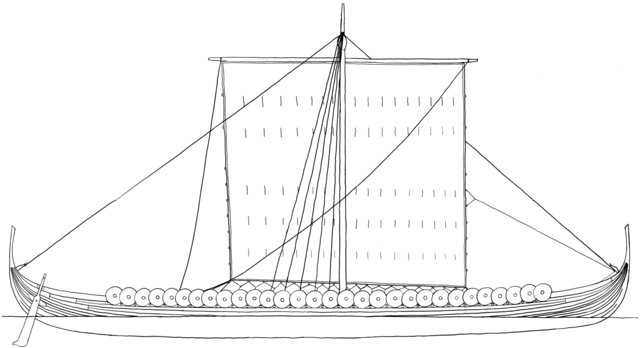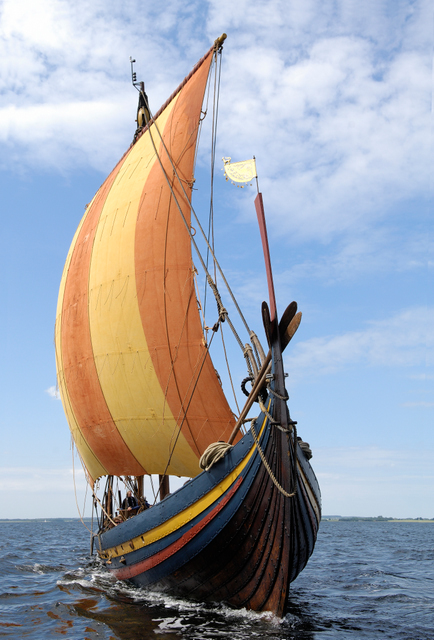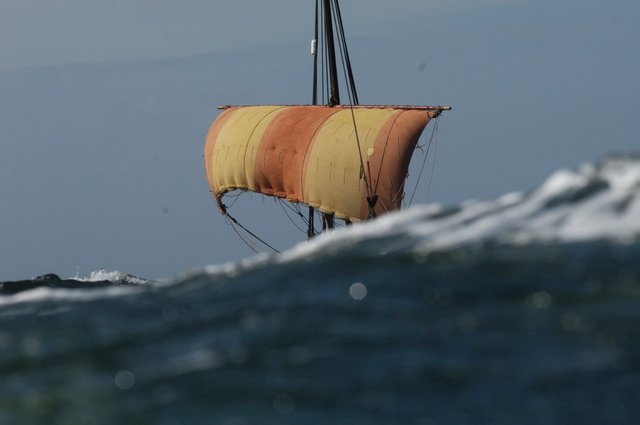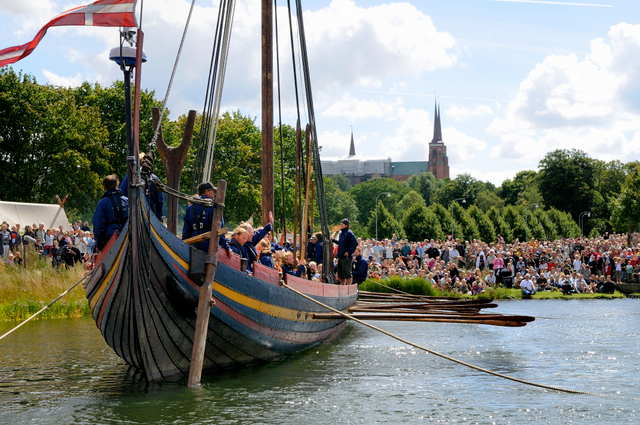Sea Stallion from Glendalough
'An ocean-going thoroughbred Reconstruction of Skuldelev 2, a large longship from the Viking Age, 1042
Reconstruction
The longship, Sea Stallion from Glendalough (in Danish Havhingsten fra Glendalough), is the largest vessel the Viking Ship Museum has build so far. With a length of 30 m, it is indeed in a special class among Viking ships. The Norwegian Viking finds, the Oseberg and Gokstad ships, are "only" 22 m and 24 m long respectively. The famous great-ship of the Norwegian king, Olav Trygvasson, "Ormen hin lange" (Long Serpent) was, according to Snorre's saga, all of 43 m long!
As can be seen in the museum hall where the original longskip is exhibited, only about 25% has been preserved. That it is possible to build a satisfactory reconstruction is solely due to the fact that the 1800 fragments that were found included essential parts of the bottom, the whole keelson and the stern - and the ship's side adjacent to the stern, right up to the gunwale. Hence, the most vital measuring points still exist.
High-quality materials were used in building the original ship, not only for the sake of appearance, but also to enhance the strength of the construction. It thus became necessary to select material for the reconstruction which as far as type and properties are concerned, came as close as possible to the original.
Building
The Vikings built their ships of fresh wood. The long planking for the ship's sides, the strakes, were cleaved from long, straight oak trunks, while the inner and more curved timbers were made from parts of the oak tree crown that had already grown into more or less the correct form. The total volume of wood required for the reconstruction is 150 stacked cubic metres. Then there are 400 kg of pure iron, hemp for the 3000 m of rope, and a great deal of flax for the sail, all 112 square metres of it!
Judging by the most recent wood and tree-ring analyses, the original ship was built in accordance with Scandinavian shipbuilding traditions in Dublin around the year 1042. The ship is thus linked with the Scandinavian expansion westwards and the history of the Vikings in Ireland. Without doubt the ship was also on the scene of many dramatic events that occurred at the end of the Viking Age, after William the Conqueror invaded England in 1066.
Sailing
The reconstructed longship was launched in 2004. Hereafter the initial sea trials and crew training took place in 2005 and 2006. Further experiments was conducted to establish sailing characteristics and seaworthiness on different types of seas and weather conditions.
In 2007 the Sea Stallion completed a voyage from Roskilde, north of Scotland to Dublin and home again the year after. This time south through the Channel and crossing the North Sea.
After a few years on land, the Viking Ship Museum decided to continue the Sea Stallion’s voyages with a summer tour around Danish waters and to Hedeby, Germany in 2012. In 2013, the Sea Stallion from Glendalough participated in the project 'When Denmark began' with visits to several Danish ports.
After the summer tour in 2013, the Viking Ship Museum announced their intention to undertake a new spectacular sailing project in line with the Dublin trip. As yet, no destination has been set for this project, but the summer voyage in 2014 was primarily intended to be a training voyage for the new crew as preparation for the longer voyage.
In 2014, the Sea Stallion from Glendalough also participated in the opening of a large Viking exhibition in Berlin by rowing down the Spree through the centre of Berlin and holding ‘open ship’ for a week, where visitors could come on board and view the ship at close quarters.
Information about Sea Stallion from Glendalough
Dockyard: The Viking Ship Museum
Boatbuilders: Ture M Møller, Thomas Finderup, Birger Andersen, Hanus Jensen, Tom Nicolajsen, Søren Andreasen, Rasmus Budde Jensen, Simon Day Larsen, Jacob Schroll, Søren Nielsen
Owner: The Viking Ship Museum
Year of construction: 2004
Length: 29.30 meter (96 feet)
Width: 3.80 meter (12 feet)
Depth/draft: 0.95 meter (3 feet)
Weight: 8.30 tons
Total sail area: 112 m2
Number of oars: 60
Displacement: 25 tons
Crew: 60-70 men
Estimated average speed, sail: 6-8 knots
Estimated maximum speed, sail: 17 knots
Estimated average speed, oars: 2.5 knots
Estimated maximum speed, oars: 4,2 knots
Remaining participating in the building:
Boatbuilders: Petter Mellberg, Kasper Krogh Hansen, Klaus Mynzberg Jensen, Michael Mellmann, Birger Christensen, Rafaello Bartolini, Lene Christensen, Pernille Voss, Alf Isak Nordli
Reconstruction: Erik Andersen, hull and rig and Morten Gøthche, drawings
Robe maker: Ole Magnus, Carsten Hvid, Kasper Kristensen and employees from Hardanger Fartøyvern senter in Norway
Blocks, wood carving: Sanne Seipelt
Black smith: Åge Frederiksen
Tradesmen's assistants: Thomas Bjørnkær, Simon Johnsom, Kristian Vadsager and students from Naturskolen, the maritime branch in Roskilde
Tar making: Kari Käkonen, Reino Pakarinen, Pertti Koivisto, Leo Heikkinen, Juha Malinen, Ari Pääkkonen, Urpo Piirainen, Toivo Hekkinen
Forester: Renee S. Jensen, Mårum
Wool, sealing: Àrni Battaberg
Painting: Vibeke Bischoff, Rikke Johansen
Gold smith: Jane Doyle, Anders Nielsen Hansen
Shield maker: Alex Mouro, Søren Balle Christiansen, Alf Isak Nordli
Sail maker: Hansen, Copenhagen




